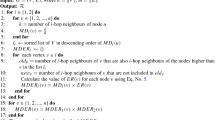Abstract
With the epidemic growth of Online Social Networks (OSNs), a large scale research on information dissemination in OSNs has been made an appearance in contemporary years. One of the essential researches is Influence Maximization. Most research adopts community structure, greedy stage, and centrality measures, to identify the influence node set. However, the time consumed in analyzing the influence node set for edge server placement, service migration and service recommendation is ignored in terms of propagation delay. Considering the above analysis, we concentrate on the issue of time-sensitive influence maximization and maximize the targeted influence spread. To solve the problem, we propose a method called, Trilateral Spearman Katz Centrality-based Least Angle Regression for influential node tracing in social network. Besides, two algorithms are used in our work to find the influential node in social network with maximum influence spread and minimal time, namely Trilateral Statistical Node Extraction algorithm and Katz Centrality Least Angle Influence Node Tracing algorithm, respectively. Extensive experiments on The Telecom dataset demonstrate the efficiency and influence performance of the proposed algorithms on evaluation metrics, namely, sensitivity, specificity, accuracy, time and influence spread.









Similar content being viewed by others
References
Zhang, Z., Li, X., & Gan, C. (2020). Identifying influential nodes in social networks via community structure and influence distribution difference. Digital Communications and Networks. Elsevier, Apr 2020 [Community Based Influence Maximization Algorithm (CBIMA)].
Khomami, M. M. D., Rezvanian, A., Meybodi, M. R., & Bagheri, A. (2020). CFIN: A community-based algorithm for finding influential nodes in complex social networks. The Journal of Supercomputing, 77, 2207–2236.
Naik, D., Behera, R. K., Ramesh, D., & Rath, S. K. (2020). Map-reduce-based centrality detection in social networks: An algorithmic approach. Arabian Journal for Science and Engineering, 45, 10199–10222.
Pereira, F. S., Gama, J., de Amo, S., & Oliveira, G. M. (2018). On analyzing user preference dynamics with temporal social networks. Machine Learning, 107(11), 1745–1773.
Zareie, A., Sheikhahmadi, A., Jalili, M., & Fasaei, M. S. K. (2020). Finding influential nodes in social networks based on neighborhoodcorrelation coefficient. Elsevier.
Zhao, N., Bao, J., & Chen, N. (2020). Ranking Influential Nodes in Complex Networks withInformation Entropy Method. Wiley.
Tian, S., Mo, S., Wang, L., & Peng, Z. (2020). Deep reinforcement learning-based approach to tackle topic-awareinfluence maximization. Springer.
Zhao, G., Jia, P., Huang, C., Zhou, A., & Fang, Y. (2020). A machine learning based framework for identifying influential nodes in complex networks. IEEE Access, 8, 65462–65471.
Li, W., Fan, Y., Mo, J., Liu, W., Wang, C., Xin, M., & Jin, Q. (2019). Three-hop velocity attenuation propagation modelfor influence maximization in social networks. Springer.
Alshahrani, M., Fuxi, Z., Sameh, A., Mekouar, S., & Huang, S. (2020). Efficient algorithms based on centrality measures for identification of top-K influential users in social networks. Elsevier.
Zhao, G., Jia, P., Zhou, A., & Zhang, B. (2020). InfGCN: Identifying influential nodes in complex networks with graphconvolutional networks. Elsevier.
Ma, T., Wang, H., Zhang, L., Tian, Y., & Al-Nabhan, N. (2020). Graph classification based on structural features of significant nodes andspatial convolutional neural networks. Elsevier.
Seo, J. H., & Kim, M. H. (2021). Finding influential communities in networks with multiple influence types. Information Sciences, 548, 254–274.
Huiyu, M., Jiuxin, C., Tangfei, Y., & Liu, B. (2020). Topic based time-sensitive influence maximization in online social networks. World Wide Web, 23(3), 1831–1859.
Song, G., Li, Y., Chen, X., He, X., & Tang, J. (2016). Influential node tracking on dynamic social network: An interchange greedy approach. IEEE Transactions on Knowledge and Data Engineering, 29(2), 359–372.
Wang, W., & Street, W. N. (2018). Modeling and maximizing influence diffusion in social networks for viral marketing. Applied network science, 3(1), 1–26.
Wei, H., Pan, Z., Hu, G., Zhang, L., Yang, H., Li, X., & Zhou, X. (2018). Identifying influential nodes based on network representation learning in complex networks. PLoS ONE. https://doi.org/10.1371/journal.pone.0200091
Olivares, R., Muñoz, F., & Riquelme, F. (2020). A multi-objective linear threshold influence spread model solved byswarm intelligence-based methods. Elsevier.
Wang, S., Zhao, Y., Xu, J., Yuan, J., & Hsu, C. (2019). Edge server placement in mobile edge computing. Journal of Parallel and Distributed Computing, 127, 160–168.
Wang, S., Zhao, Y., Huang, L., Xu, J., & Hsu, C. (2019). QoS prediction for service recommendations in mobile edge computing. Journal of Parallel and Distributed Computing, 127, 134–144.
Guo, Y., Wang, S., Zhou, A., Xu, J., Yuan, J., & Hsu, C. (2020). User allocation-aware edge cloud placement in mobile edge computing. Software: Practice and Experience, 50(5), 489–502.
Wang, S., Guo, Y., Zhang, N., Yang, P., Zhou, A., & Shen, X. S. (2019). Delay-aware microservice coordination in mobile edge computing: A reinforcement learning approach. IEEE Transactions on Mobile Computing https://ieeexplore.ieee.org/document/8924682
Author information
Authors and Affiliations
Corresponding author
Ethics declarations
Conflicts of interest
None.
Additional information
Publisher's Note
Springer Nature remains neutral with regard to jurisdictional claims in published maps and institutional affiliations.
Rights and permissions
About this article
Cite this article
Kumar, P.V., Balasubramanian, C. Trilateral Spearman Katz Centrality Based Least Angle Regression for Influential Node Tracing in Social Network. Wireless Pers Commun 122, 2767–2790 (2022). https://doi.org/10.1007/s11277-021-09029-3
Accepted:
Published:
Issue Date:
DOI: https://doi.org/10.1007/s11277-021-09029-3




